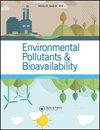Speciation and mobility of lead in shooting range soils
Q3 Chemical Engineering
引用次数: 42
Abstract
Abstract The mobility and bioavailability of lead (Pb) in seven military shooting range soils found in eastern and north eastern Botswana were studied using sequential extraction procedure. The different forms of Pb and their reactivity in the soil help explain their speciation, mobility and bioavailability in the environment. Mobility of Pb in the berm soils in all the seven shooting ranges was found to be over 90% implying high Pb lability. The bioavailability index of Pb was in the range 60–90%, an indication that most of the Pb can be available for plant uptake. Sequential extraction studies indicate that the partitioning of Pb was mostly confined to the carbonate compartment in all the shooting ranges. All the seven shooting ranges failed the Synthetic Precipitation Leaching Procedure (SPLP) with SPLP Pb concentrations exceeding United States Environmental Protection Agency (USEPA) 0.015 mg/kg critical level of hazardous waste, posing a pollution threat to surface and groundwater.射击场土壤中铅的形态和流动性
摘要采用顺序提取法研究了博茨瓦纳东部和东北部7种军用射击场土壤中铅的迁移率和生物利用度。铅在土壤中的不同形式及其反应性有助于解释其在环境中的形态、流动性和生物利用度。在所有七个射击场的护堤土壤中,铅的迁移率都超过90%,这意味着铅的不稳定性很高。铅的生物利用度指数在60-90%之间,这表明大部分铅可用于植物吸收。连续提取研究表明,在所有射击场中,Pb的分配大多局限于碳酸盐岩隔室。所有七个射击场都未通过合成降水浸出程序(SPLP),SPLP Pb浓度超过美国环境保护局(USEPA)0.015 mg/kg的危险废物临界水平,对地表和地下水构成污染威胁。
本文章由计算机程序翻译,如有差异,请以英文原文为准。
求助全文
约1分钟内获得全文
求助全文
来源期刊
CiteScore
1.62
自引率
0.00%
发文量
0
审稿时长
1 months
期刊介绍:
Chemical Speciation & Bioavailability ( CS&B) is a scholarly, peer-reviewed forum for insights on the chemical aspects of occurrence, distribution, transport, transformation, transfer, fate, and effects of substances in the environment and biota, and their impacts on the uptake of the substances by living organisms. Substances of interests include both beneficial and toxic ones, especially nutrients, heavy metals, persistent organic pollutants, and emerging contaminants, such as engineered nanomaterials, as well as pharmaceuticals and personal-care products as pollutants. It is the aim of this Journal to develop an international community of experienced colleagues to promote the research, discussion, review, and spread of information on chemical speciation and bioavailability, which is a topic of interest to researchers in many disciplines, including environmental, chemical, biological, food, medical, toxicology, and health sciences.
Key themes in the scope of the Journal include, but are not limited to, the following “6Ms”:
Methods for speciation analysis and the evaluation of bioavailability, especially the development, validation, and application of novel methods and techniques.
Media that sustain the processes of release, distribution, transformation, and transfer of chemical speciation; of particular interest are emerging contaminants, such as engineered nanomaterials, pharmaceuticals, and personal-care products.
Mobility of substance species in environment and biota, either spatially or temporally.
Matters that influence the chemical speciation and bioavailability, mainly environmentally relevant conditions.
Mechanisms that govern the transport, transformation, transfer, and fate of chemical speciation in the environment, and the biouptake of substances.
Models for the simulation of chemical speciation and bioavailability, and for the prediction of toxicity.
Chemical Speciation & Bioavailability is a fully open access journal. This means all submitted articles will, if accepted, be available for anyone to read, anywhere, at any time. immediately on publication. There are no charges for submission to this journal.

 求助内容:
求助内容: 应助结果提醒方式:
应助结果提醒方式:


